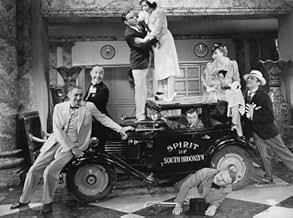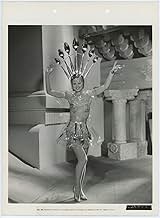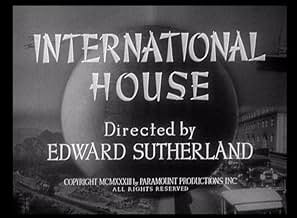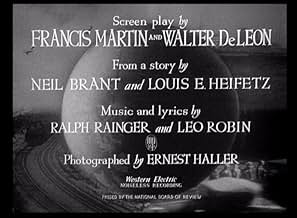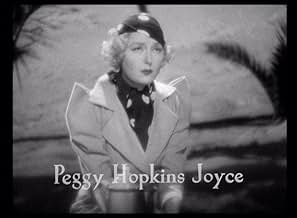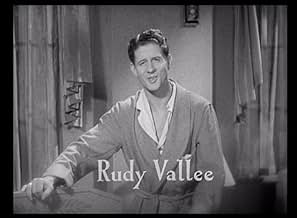IMDb RATING
6.9/10
1.5K
YOUR RATING
Assorted wacky characters converge on a Chinese hotel to bid on a new invention: television.Assorted wacky characters converge on a Chinese hotel to bid on a new invention: television.Assorted wacky characters converge on a Chinese hotel to bid on a new invention: television.
Rose Marie
- Rose Marie
- (as Baby Rose Marie)
Featured reviews
Why did Gracie Allen's sister learn French? Because she inadvertently took home a French baby, rather than her own, and wanted to be able to talk to him when he grew up. And why does cheerfully soused W.C. Fields have a roadster in his auto-gyro? For side-trips, of course -- like the one that takes him careening through the corridors, lounges and lobbies of the grandest hotel in Wu Hu China. It's right across the street from the flophouse where Bela Lugosi as gold digger Peggy Ann Joyce's insanely jealous ex-husband has been forced to reside. As for how Cab Calloway, singing a tribute to the heady pleasures of pot, and Rudy Vallee, serenading his megaphone, wander into the movie, they're among the images scanned up by a Chinese inventor who's attempting to televise a six-day bike race before television (as we know it today) was invented. Other pleasures in "International House" range from ten-year-old baby RoseMarie (who would eventually be the adult RoseMarie of the "Dick Van Dyke Show") doing a Sophie Tucker low blues and some surprisingly agile hoofing by Sterling Halloway. Fields' mumbling, bumbling, boozy millionaire staggers off with the comedy honors. But you don't even have to be Wiliam Claude Dukenfeld fan to find a lot to enjoy.
I've always wanted to use the word 'melange' in a review and here I finally have done it. That word is appropriate because this film is jam-packed with a wide variety of items--like a chef salad of films! There's a lot of comedy with W.C. Fields as well as Burns and Allen, romance with Stu Erwin and his sweetie, a jealous ex-husband (Bela Lugosi) and a lot of special appearances by radio stars (such as Baby Rose Marie--the same lady who later starred on "The Dick Van Dyke Show") and Cab Calloway--singing the ultra-bizarre "Reefer Man"--a film that makes fun of pot smoking! Yes, I did mean marijuana! This Pre-Code film has a lot of racy material other than the film--such as plenty of double-entendres by Fields, cohabitation and a song and dance number with surprisingly scantily clad ladies. Only a year later, after a tougher Production Code was enacted, much of this film simply wouldn't have been allowed--it just wasn't "proper family entertainment" according to the Hays Office (which is lampooned in a comment by Fields late in the film).
In many ways, the film is like a variety show and the plot really is rather irrelevant, though it is interesting to see such an early film talk about and supposedly demonstrate television. With so much variety in the film, many of the segments fall a bit short, but since they come and go so quickly, you're bound to be entertained only a moment later. Not great entertainment, but clearly an important film for lovers of classic cinema.
In many ways, the film is like a variety show and the plot really is rather irrelevant, though it is interesting to see such an early film talk about and supposedly demonstrate television. With so much variety in the film, many of the segments fall a bit short, but since they come and go so quickly, you're bound to be entertained only a moment later. Not great entertainment, but clearly an important film for lovers of classic cinema.
INTERNATIONAL HOUSE (Paramount, 1933), directed by A. Edward Sutherland, is a minor comedy that has grown into a classic, thanks to its frequent television revivals over the last few decades, later distribution on video cassette and DVD, and classic movie cable channels, first on American Movie Classics in 1992, and then, nearly ten years later, its resurrection again, this time on Turner Classic Movies, in 2001. After all these years, this 1933 gem is still very funny.
Set in Wu-Wu, China, Doctor Wong (Edmund Breese), the inventor of the radio scope (now known as television), is staying at the International House, a luxurious hotel, where he plans to meet with representatives who want to submit bids to buy his invention. One of them is Tommy Nash (Stuart Erwin), an employer for the American Electric Company visiting China on behalf of his firm. Unable to get a train to Wu-Wu (the bridge is washed out), he decides to take his car and drive there. At the train station, he encounters Peggy Hopkins Joyce (Peggy Hopkins Joyce), who overhears his plans and talks herself into riding with Nash, in hope to also get to the International House and see this latest invention that has made news headlines. Reaching International House, Tommy locates his fiancée, Carol Fortescue (Sari Maritza), who is upset because she has learned about his lady passenger, causing friction in their relationship. Complications ensue when Tommy, who always acquires some childish diseases such as chicken pox or mumps, acquires the measles and is put in quarantine, although in reality he has only a harmless rash. But this is the way one of Nash's competitors, General Nick Petronovich (Bela Lugosi), also one of Peggy Joyce's ex-husbands, puts him away while he tries to submit a bid for the radio scope. His plan fails when the entire hotel is quarantined and Petronovich finds he is unable to return inside the hotel, forcing himself to obtain a room at a sleazy hotel across the street.
Also at the hotel are Doctor Burns and Nurse Allen (George Burns and Gracie Allen); Lumsden Hare as the confused Sir Mortimer Fortescue, Carol's father; and Franklin Pangborn as the harassed hotel manager. Nearly a half hour from the start of the story comes Professor Henry R. Quail (WC Fields), entering the hotel rooftop via his auto gyro (airplane) from Juarez, Mexico, looking for Kansas City. Since Kansas City is "lost", Quail is here to stay at International House, disrupting everything and everyone around, which leads to misunderstandings, such as Petronovich witnessing from the hotel room across the street Quail sleeping in the same room as his ex-wife, Peggy, to a wild and crazy chase that leads Quail to drive his little car around the hotel and down the fire escape. (For any Paramount movie of this sort, "Anything Goes," so don't explain logic). The Burns and Allen comedy exchanges, which are part of the storyline, succeeds in stirring up some chuckles today. And see who gets the last laugh when Fields encounters Gracie wanting his autograph.
Aside from 70 minutes of sheer comedy madness and very risqué dialog that somehow got past the censors, INTERNATIONAL HOUSE takes time for some forgettable tunes written by Leo Robin and Ralph Rainger. The first, a production number that echoes a Busby Berkeley dance routine, is "The Chinese Teacup and the Coffee Mug" (performed on the rooftop by Sterling Holloway and Lona Andre, sung by an unidentified and unseen vocalist). As Doctor Wong demonstrates his invention by trying desperately to get the Six Day Bicycle Race, the radio scope picks up famous entertainers of the day, such as Colonel Stoopnagle and Budd demonstrating their numerous inventions such as a revolving gold fish, a one dimensional alarm clock, etc., which sounds all "too peachy"; to vocalists singing songs, including "Thank Heaven for You" (sung by Rudy Vallee); "My Blue Bird is Singing the Blues" (sung by Baby Rose Marie); and "The Reefer Man" (sung by Cab Calloway and his band). All these musical interludes are brief, usually under five minutes. "The Reefer Man" was one song that suffered the TV's ax from some commercial TV stations, along with what Fields says when he finds a cat in his car, but fortunately these scenes have been restored. An instrumental song, "Look What I've Got," (introduced in a Maurice Chevalier musical, A BEDTIME STORY, 1933) is played during a hilarious scene where Fields and Joyce are preparing to take their showers and go to bed, unaware of each other's presence in the bedroom. This segment alone must be seen to be believed.
In spite of former famous Ziegfeld showgirl Peggy Hopkins Joyce obtaining top-billing in the cast, it is today acclaimed a W.C. Fields comedy. He practically walked off with the movie. At the time of the film's release, Joyce was not only well-known world wide celebrity with numerous ex-husbands, but a headliner in many circulated newspapers. Today she is virtually forgotten and her name rests in the land of the obscure. To learn more about this once famous actress, here appearing in her only talkie and final film, read the 2000 biography by Constance Rosenblum titled "Gold Digger: The Outrageous Life of Peggy Hopkins Joyce," and then go see this movie. (***)
Set in Wu-Wu, China, Doctor Wong (Edmund Breese), the inventor of the radio scope (now known as television), is staying at the International House, a luxurious hotel, where he plans to meet with representatives who want to submit bids to buy his invention. One of them is Tommy Nash (Stuart Erwin), an employer for the American Electric Company visiting China on behalf of his firm. Unable to get a train to Wu-Wu (the bridge is washed out), he decides to take his car and drive there. At the train station, he encounters Peggy Hopkins Joyce (Peggy Hopkins Joyce), who overhears his plans and talks herself into riding with Nash, in hope to also get to the International House and see this latest invention that has made news headlines. Reaching International House, Tommy locates his fiancée, Carol Fortescue (Sari Maritza), who is upset because she has learned about his lady passenger, causing friction in their relationship. Complications ensue when Tommy, who always acquires some childish diseases such as chicken pox or mumps, acquires the measles and is put in quarantine, although in reality he has only a harmless rash. But this is the way one of Nash's competitors, General Nick Petronovich (Bela Lugosi), also one of Peggy Joyce's ex-husbands, puts him away while he tries to submit a bid for the radio scope. His plan fails when the entire hotel is quarantined and Petronovich finds he is unable to return inside the hotel, forcing himself to obtain a room at a sleazy hotel across the street.
Also at the hotel are Doctor Burns and Nurse Allen (George Burns and Gracie Allen); Lumsden Hare as the confused Sir Mortimer Fortescue, Carol's father; and Franklin Pangborn as the harassed hotel manager. Nearly a half hour from the start of the story comes Professor Henry R. Quail (WC Fields), entering the hotel rooftop via his auto gyro (airplane) from Juarez, Mexico, looking for Kansas City. Since Kansas City is "lost", Quail is here to stay at International House, disrupting everything and everyone around, which leads to misunderstandings, such as Petronovich witnessing from the hotel room across the street Quail sleeping in the same room as his ex-wife, Peggy, to a wild and crazy chase that leads Quail to drive his little car around the hotel and down the fire escape. (For any Paramount movie of this sort, "Anything Goes," so don't explain logic). The Burns and Allen comedy exchanges, which are part of the storyline, succeeds in stirring up some chuckles today. And see who gets the last laugh when Fields encounters Gracie wanting his autograph.
Aside from 70 minutes of sheer comedy madness and very risqué dialog that somehow got past the censors, INTERNATIONAL HOUSE takes time for some forgettable tunes written by Leo Robin and Ralph Rainger. The first, a production number that echoes a Busby Berkeley dance routine, is "The Chinese Teacup and the Coffee Mug" (performed on the rooftop by Sterling Holloway and Lona Andre, sung by an unidentified and unseen vocalist). As Doctor Wong demonstrates his invention by trying desperately to get the Six Day Bicycle Race, the radio scope picks up famous entertainers of the day, such as Colonel Stoopnagle and Budd demonstrating their numerous inventions such as a revolving gold fish, a one dimensional alarm clock, etc., which sounds all "too peachy"; to vocalists singing songs, including "Thank Heaven for You" (sung by Rudy Vallee); "My Blue Bird is Singing the Blues" (sung by Baby Rose Marie); and "The Reefer Man" (sung by Cab Calloway and his band). All these musical interludes are brief, usually under five minutes. "The Reefer Man" was one song that suffered the TV's ax from some commercial TV stations, along with what Fields says when he finds a cat in his car, but fortunately these scenes have been restored. An instrumental song, "Look What I've Got," (introduced in a Maurice Chevalier musical, A BEDTIME STORY, 1933) is played during a hilarious scene where Fields and Joyce are preparing to take their showers and go to bed, unaware of each other's presence in the bedroom. This segment alone must be seen to be believed.
In spite of former famous Ziegfeld showgirl Peggy Hopkins Joyce obtaining top-billing in the cast, it is today acclaimed a W.C. Fields comedy. He practically walked off with the movie. At the time of the film's release, Joyce was not only well-known world wide celebrity with numerous ex-husbands, but a headliner in many circulated newspapers. Today she is virtually forgotten and her name rests in the land of the obscure. To learn more about this once famous actress, here appearing in her only talkie and final film, read the 2000 biography by Constance Rosenblum titled "Gold Digger: The Outrageous Life of Peggy Hopkins Joyce," and then go see this movie. (***)
Paramount had the brilliant idea of featuring radio in the movies the previous year with The Big Broadcast. That film featured all kinds of radio stars the public only imagined and had an anarchic plot similar to International House.
I've often wondered if Paramount didn't mean to have this be The Big Broadcast of 1933 originally. Repeating from the cast of The Big Broadcast are Stu Erwin and Burns & Allen and Cab Calloway. Adding to the general hilarity are W.C. Fields, Franklin Pangborn, Rudy Vallee, Bela Lugosi, and the Paris Hilton of her day, Peggy Hopkins Joyce.
The slender thread of a plot this movie hangs on involves a Chinese inventor Edmund Breon who invents the seeing eye, radio you can see as well as listen to. Everyone wants to get their hands on this valuable patent. A lot of the musical guest stars get hooked into the film via the inventor testing out the device.
Bing Crosby made his feature film starring debut in The Big Broadcast and I wonder why his crooning rival Rudy Vallee was hired for this film. Rudy has a nice, but unmemorable number.
Of course what makes the film really go are Burns and Allen and W.C. Fields. They uplift any film they are in. George and Gracie's montypythonesque type dialog is timeless and priceless.
So is Fields of course, the eternal misanthrope. There was one bit of humor I caught in International House though that is rather dated. During that final chase scene through the International House lobby with Fields in an automobile, he pokes his head through the car roof and puts his top hat on. He then remarks something about this car used to belong to the Postmaster General.
As it turns out Herbert Hoover's Postmaster General was a rather fatuous gentlemen named Walter Brown. He liked to wear high silk hats and had a limousine designed with an extra tall roof so he could ride with his topper on. At government expense of course in the middle of the Depression. He was forever derided as High Hat Brown after that and even a year later after Hoover was out of office, W.C. Fields could wring a laugh or two with that crack from the Depression audience.
Still though, this should really be called The Big Broadcast of 1933.
I've often wondered if Paramount didn't mean to have this be The Big Broadcast of 1933 originally. Repeating from the cast of The Big Broadcast are Stu Erwin and Burns & Allen and Cab Calloway. Adding to the general hilarity are W.C. Fields, Franklin Pangborn, Rudy Vallee, Bela Lugosi, and the Paris Hilton of her day, Peggy Hopkins Joyce.
The slender thread of a plot this movie hangs on involves a Chinese inventor Edmund Breon who invents the seeing eye, radio you can see as well as listen to. Everyone wants to get their hands on this valuable patent. A lot of the musical guest stars get hooked into the film via the inventor testing out the device.
Bing Crosby made his feature film starring debut in The Big Broadcast and I wonder why his crooning rival Rudy Vallee was hired for this film. Rudy has a nice, but unmemorable number.
Of course what makes the film really go are Burns and Allen and W.C. Fields. They uplift any film they are in. George and Gracie's montypythonesque type dialog is timeless and priceless.
So is Fields of course, the eternal misanthrope. There was one bit of humor I caught in International House though that is rather dated. During that final chase scene through the International House lobby with Fields in an automobile, he pokes his head through the car roof and puts his top hat on. He then remarks something about this car used to belong to the Postmaster General.
As it turns out Herbert Hoover's Postmaster General was a rather fatuous gentlemen named Walter Brown. He liked to wear high silk hats and had a limousine designed with an extra tall roof so he could ride with his topper on. At government expense of course in the middle of the Depression. He was forever derided as High Hat Brown after that and even a year later after Hoover was out of office, W.C. Fields could wring a laugh or two with that crack from the Depression audience.
Still though, this should really be called The Big Broadcast of 1933.
Although he's on the screen for only half the time this is classic early Fields. Before he became the put upon family man he was this obnoxious but nevertheless hilarious blustering boasting egomaniac. Perfect scene with him and Gracie Allan. Fields is at his nastiest best here- "what is the penalty for murder in China?" Gracie Allan is equally funny with George Burns impeccable as her comedy foil. I loved the line about not telling where she went to school.. There are other highlights as well.Skip the stupid romance and most of the Peggy Hopkins Joyce scenes but enjoy the pre-code sexiness, particularly in the Tea-Cup number and Fields comment after looking in a key hole at the hotel. A fast wild ride a'la 30's comedy and not to be missed by fans of the genre.
Did you know
- TriviaDuring the filming of one of W.C. Fields' scenes, a mild earthquake struck Los Angeles. The earthquake was supposedly captured on film. In the film clip, Fields and his co-stars are standing in the hotel lobby set, when the picture begins to shake as if the camera is vibrating. A chandelier on the set begins to swing back and forth, and a lamp suddenly falls over. Fields calmly ushers his co-stars off the soundstage, telling them to stay calm and walk slowly. The "earthquake footage" of Fields was played in newsreels across the country in the weeks following the 1933 quake. Nearly forty years later, however, director A. Edward Sutherland admitted that the "earthquake footage" was a hoax concocted by himself and Fields. It was done by rigging wires on the lamp and chandelier, and shaking the camera to simulate an earthquake. Sutherland claimed that he and Fields were amazed when the "earthquake footage" was accepted as genuine by newsreel distributors. "We shared a big laugh and an even bigger drink", Sutherland recalled. To this day, the fake "earthquake footage" is occasionally broadcast and accepted as genuine by entertainment television shows such as Access Hollywood (1996). The footage appeared in Hollywood Graffiti (1983).
- GoofsDuring the scene where Prof. Henry R. Quail is by his auto gyro talking to Doctor Wong and Peggy Hopkins Joyce, you can see the shadow of the boom mic moving above their heads. The boom mic then hits something, presumably the auto gyro, making a noise which makes Prof. Henry R. Quail and Peggy Joyce look up.
- Quotes
Professor Quail: Hey! Where am I?
Woman: Wu-Hu.
Professor Quail: Woo-Hoo to you sweetheart. Hey Charlie, where am I?
Hotel Manager: WU-HU!
[Professor Quail removes the flower from his lapel]
Professor Quail: Don't let the posey fool you!
- ConnectionsFeatured in Oops, those Hollywood Bloopers! (1982)
- SoundtracksShe Was a China Tea-cup and He Was Just a Mug
(1933) (uncredited)
Lyrics by Leo Robin
Music by Ralph Rainger
Sung offscreen by an unidentified man and danced by Sterling Holloway, Lona Andre,
Mary Jane Sloan, Gwen Zetter and Chorus
- How long is International House?Powered by Alexa
Details
- Runtime1 hour 8 minutes
- Color
- Aspect ratio
- 1.37 : 1
Contribute to this page
Suggest an edit or add missing content



